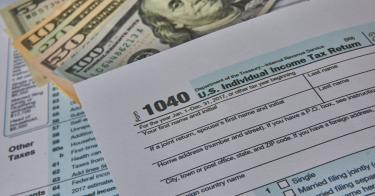Chances are, you're one of the 90 percent of Americans who have bigger paychecks due to the tax reform that Congress passed last year. The Tax Cuts and Jobs Act (TCJA) cut taxes for individual Americans, lowered businesses taxes and made investment in the United States more attractive, which will combine to increase incomes even more. Last year, one of us estimated that the total effects of the law will increase incomes by about $3,000 per American household.
That's pretty good, but we think Congress could do even better. Two simple changes based on those already in the TCJA could more than double the economic benefits.
Tax reform helps the economy in a number of ways. Lower tax rates mean that businesses want to invest more in America by making it less expensive to do so. More capital investment means higher incomes for shareholders and stronger retirement accounts.
Businesses aren't waiting around to take advantage of the new law. New investment spending by companies in the S&P 500 is 24 percent higher than a year earlier, which is the fastest rate of increase since the economy climbed out of the last recession. The NFIB's small business optimism index is entering its 16th month of historically high levels.
But the benefits don't stop there. When companies invest in new capital, they provide American workers with better tools to use on the job. With more and better tools, workers are more productive, meaning each hour of work is more valuable. When workers are more productive, businesses want to hire more of them and can afford to pay higher wages.
However, as written, many of the law's changes are temporary. Most taxes go back up after 2025. If the taxes go back up, then businesses won't continue to invest in America, and the economy will fall back to its previous path.
Moreover, businesses plan investments while looking far into the future, often well outside the 10-year budget window used by Congress. Future tax rates have economic effects today. For this reason, nearly all economists agree that temporary tax cuts have weaker economic effects than permanent tax cuts.
In a recent Heritage Foundation report, we estimate that simply making the temporary provisions permanent would cause the economy to be 2.8 percent larger than it would have been without tax reform. For reference, we estimate the law as it stands to increase GDP by 1.7 percent from the pre-reform baseline.
That's step one. Make the tax cuts permanent.
Step two simplifies how businesses are taxed on their investments. Before the TCJA, the United States used a complex system that makes businesses wait to deduct the cost of their investments from their taxable income. The delay between when businesses actually pay for the investment and when the IRS says they can deduct it from taxable income makes investment more expensive and shrinks incomes.
The TCJA fixed this by allowing businesses to write off new investments immediately after they are made. In the language of tax policy, this is called expensing. However, expensing under current law only applies to certain investments that have shorter working lives, like equipment and machinery. Buildings, such as new manufacturing floor space and store fronts, still have to use the costly, complicated old system.
Expanding expensing to all investments, paired with permanent tax cuts, would increase U.S. GDP by 4.3 percent over the pre-reform baseline. That is more than double the 1.7 percent increase that would occur with the law as written.
Our proposed changes simply build on improvements already included in the TCJA. Congress included half-hearted temporary measures in the law to satisfy procedural rules, not because it represents the best economic policy. Americans should know how much money Congress is leaving on the table. Our estimates suggest that it's about $4,000 per year for the average household.
With the two simple changes we propose, Congress could offer even more economic opportunity to hard-working Americans. The policies encourage investment by making it less expensive. More investment raises wages by making workers more productive. The end result is higher incomes for Americans.
This piece originally appeared in ArcaMax




